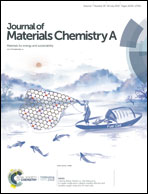Synergistic electrocatalysis of polysulfides by a nanostructured VS4-carbon nanofiber functional separator for high-performance lithium–sulfur batteries†
Abstract
The sluggish redox kinetic and the severe shuttle effect remain the key issues for the application of lithium–sulfur batteries, resulting in low sulfur utilization and rapid capacity fading. Herein, a nanostructured VS4 anchored on defect-rich carbon nanofibers (CNF-VS4) was coated on the commercial separator as both physical blocks to mitigate the shuttle effects and as an electrocatalyst to enhance the reaction kinetics of polysulfides/Li2S. Besides, polar nanostructured VS4 shows a high affinity to polysulfides, and conductive CNF network serves as “second collector” to trap and reutilize the active materials. The functional coating layer also provides rich defects for the dispersion and stabilization of Li2S. When the CNF-VS4 functional separator based on a high-sulfur content (80 wt%) cathode was applied in Li–S batteries, a high initial capacity of 1135 mA h g−1 at 0.2C and a superior rate capacity of 780 mA h g−1 at 2C were achieved. Even under a higher rate (5C), it still delivered a stable capacity of 300 mA h g−1 over 1000 cycles with a high coulombic efficiency of 95%.



 Please wait while we load your content...
Please wait while we load your content...